30 min read
HubSpot's Content Hub: A Comprehensive Guide for Business Growth
 George B. Thomas
Apr 13, 2024 9:43:17 AM
George B. Thomas
Apr 13, 2024 9:43:17 AM
What is HubSpot Content Hub?
HubSpot Content Hub is a comprehensive platform designed to enhance and simplify content marketing efforts. It integrates tools for creating, managing, optimizing, and analyzing content across various channels into one cohesive system. Ideal for marketers, content creators, and business owners, HubSpot Content Hub streamlines content workflows, automates processes and provides detailed insights into content performance. This allows users to manage their content strategy efficiently, ensuring alignment across sales, marketing, and customer service for a unified brand message. With its user-friendly interface and powerful capabilities, HubSpot Content Hub is a versatile tool that supports content marketing strategies in businesses of all sizes, helping them to achieve greater impact and improved ROI.
Table Of Contents
Hello friends! George B. Thomas here. This comprehensive guide on the HubSpot Content Hub has been built with love for business owners and marketers who want to add value to their digital worlds! Today, we're diving into a game-changing tool that's turning heads in the business world: HubSpot's Content Hub. You're in the right place if you aim to supercharge your business with invaluable, educational content.
💥 Related: A Candid Look at What the HuSpot Content Hub Is (+ Isn't)!
At Sidekick Strategies, we believe that the right content can educate, empower, and elevate your business to new heights. This guide will walk you through everything the HubSpot Content Hub offers, from its foundational features to advanced integrations that can transform your content strategy. Prepare for a journey that could redefine how you engage with your audience and drive business growth.
What is the HubSpot Content Hub?
The HubSpot Content Hub is an advanced, integrated platform designed to manage and enhance all aspects of a business's content strategy. It's part of HubSpot's suite of tools, tailored explicitly for content marketers looking to streamline their efforts across various marketing funnel stages.
Now, for some of you long-time HubSpot users, you may be wondering:
"Wait a Minute, What Happened to the HubSpot CMS Hub?"
That's a great question! The transformation from the HubSpot CMS Hub to the HubSpot Content Hub signifies a shift towards a more comprehensive and dynamic approach to content management. This change reflects HubSpot's commitment to providing users with a centralized platform that not only manages content but also enhances it with advanced AI, analytics, and integrations.
By rebranding as the Content Hub, HubSpot aims to emphasize the platform's focus on enabling users to create, optimize, and distribute content that drives meaningful interactions and fosters customer relationships throughout the entire marketing journey. This evolution underscores HubSpot's dedication to staying at the forefront of content management and ensuring that businesses have the tools they need to succeed in today's digital landscape.
💥 Related: Is the HubSpot Content Hub Still a Business Website CMS?
The Content Hub leverages AI, CMS features, and robust tracking and analytics to help users create, manage, and optimize content that fuels the customer journey. Key functionalities of the HubSpot Content Hub include:
- Content Creation and Optimization: It provides tools that assist in creating high-quality content optimized for search engines and user engagement. This includes SEO recommendations, readability adjustments, and style tips.
- Content Management: Users can organize, schedule, and publish content across different platforms directly from the HubSpot interface, making it easier to maintain a consistent content calendar.
- Analytics and Performance Tracking: The platform offers detailed analytics on how content performs, giving insights into engagement metrics, conversion rates, and overall impact on marketing goals.
- Integration with Other HubSpot Hubs: The Content Hub seamlessly integrates with other HubSpot services, such as the Marketing Hub, Sales Hub, and Service Hub, allowing a unified approach to inbound campaigns and strategies.
- AI-powered Tools: HubSpot's Content Hub leverages advanced AI technologies to enhance various aspects of your content marketing strategy.
HubSpot's Content Hub is designed to be a comprehensive solution for content marketers who need a centralized platform to manage a sophisticated content strategy effectively. It's beneficial for businesses looking to leverage content to educate, engage, and convert their target audience in a streamlined and cohesive manner.

Whether you're strategizing blog posts, scheduling social media content, or analyzing the effectiveness of your latest campaign, everything happens here. During one of our HubHeroes Podcast episodes, we dove deep into how this new HubSpot Hub isn't just about storing your content—it's about making it work smarter.
💥 Go Deeper: Why Go HubSpot? (Free Ultimate Business Growth Guide)
We discussed its ability to integrate with other HubSpot Hubs, bringing a seamless flow to your sales, marketing, and customer service efforts because all departments can leverage the power of your content!
The Evolution of Content Management in Business
Let's take a moment to reflect on where we've come from to appreciate where we're heading. The evolution of content management in business is a story of transformation—from simple blog posts to complex digital experiences that engage users at every touchpoint. Content management systems (CMS) started as the backbone for website content but have grown.
💥 Related: The Last SEO Content Strategy Guide You'll Ever Need
While we no longer call HubSpot a CMS or use the term HubSpot CMS, we can't forget that's exactly what it was before being reborn as the HubSpot Content Hub. But more on that later.
As we discussed on the HubHeroes Podcast, the traditional CMS was about managing the "what" of content—like creating and storing web pages. But today, with platforms like the HubSpot Content Hub, it's all about managing the "how" and the "why."
- Why does this piece of content exist?
- How is it performing?
- How does it lead our customers on a journey from awareness to decision?
The Content Hub flips the script by managing content and turbocharging it with AI, analytics, and integrations that turn simple content actions into customer delight moments.
This evolution reflects a broader shift in business from pushing content to creating conversations, from talking to listening, from noise to meaningful interactions. We're not just filling up space on the internet; we're crafting pathways for prospects to become passionate customers and, even better, vocal advocates.
As we embrace the HubSpot Content Hub, let's remember this is about more than just doing things the way they've always been done. It's about moving forward, leveling up, and transforming content into a dynamic tool that drives growth and builds relationships.
Ready to dive deeper?
Let's keep this conversation going and turn your content into a hero your business deserves.
Core Features of HubSpot Content Hub
Navigating the content landscape can feel like steering a ship through misty seas. But fear not; HubSpot's Content Hub has a treasure trove of features designed to make your journey smooth and your strategies sharp. Let's dive into some core features that make the Content Hub an essential tool for any content marketer or business owner aiming to elevate their game.
💥 Related: What Is the HubSpot Flywheel? Is the Inbound Funnel Dead?
Let's start with the shiny new AI tools we, business owners and marketers, have at our fingertips. But, as I type that, NO! Content Hub is not just a set of new AI tools.
Okay, let's get back into the good stuff.
AI-Powered Content Generation
First, AI-powered content generation is a real game-changer in creating content. This isn't just about speeding up production; it's about enhancing quality and relevance at scale. The AI in HubSpot Content Hub can help generate topic ideas, suggest content outlines, and even draft content that aligns with your SEO goals and brand voice.

Imagine having a brainstorming buddy dialed into your audience's needs and the latest SEO trends, ready to help you produce targeted, engaging content. During a HubHeroes Podcast, we marveled at how this AI doesn't just regurgitate information—it learns and adapts. It's like having a new team member who is constantly updated on what's working in digital marketing.
This feature is convenient for teams looking to maintain a high content cadence without sacrificing the personalized touch that audiences crave.
HubSpot Remix Feature: Content Confetti
HubSpot's Remix feature is a transformative tool within the Content Hub that enables businesses to maximize the value of their existing content. This feature allows marketers and business owners to effortlessly repurpose and redistribute content across various channels. Understanding what Remix is, why it's essential, and how it can benefit your marketing strategy is crucial for any content-driven business.
What is HubSpot Remix?
HubSpot Remix is a content optimization tool designed to help users effortlessly repurpose their existing content into new formats suitable for different platforms and audiences. This feature uses AI technology to analyze content and suggests new ways to adapt and share it.
💥 Related: How Have Inbound and HubSpot Changed? (HubHeroes Podcast)
Whether turning a detailed blog post into a series of social media snippets, or in the future transforming a webinar into a video tutorial series (crystal ball moment), or converting a case study into an infographic, Remix makes these tasks more straightforward and efficient.
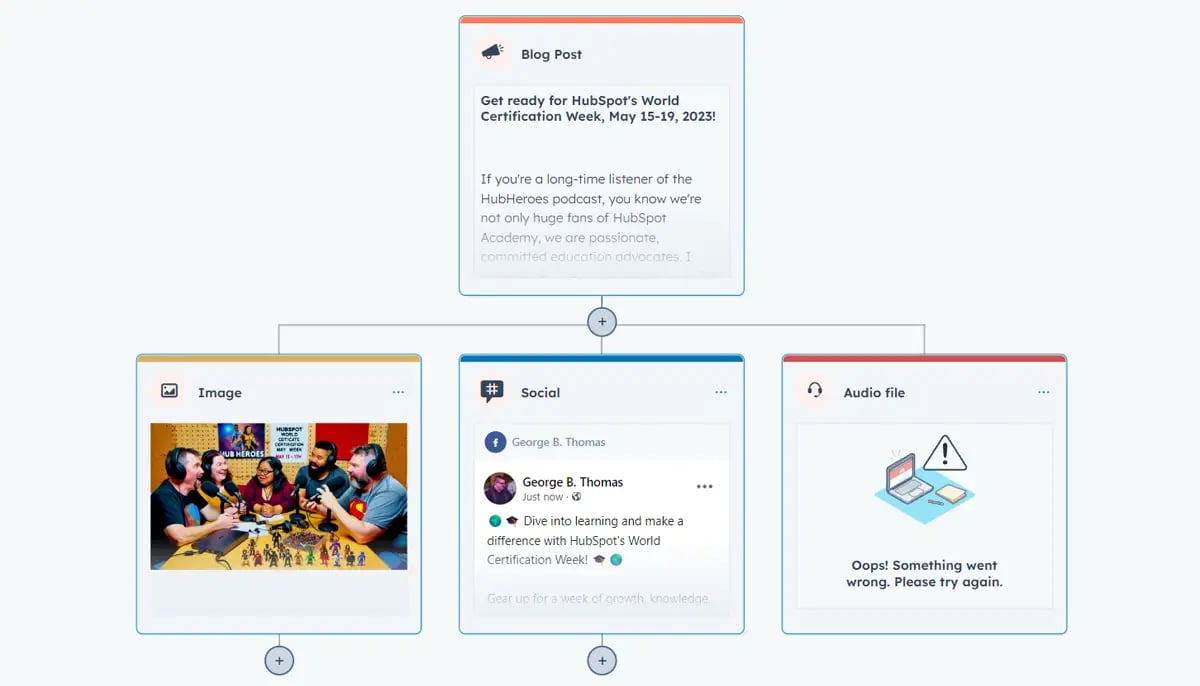
Why is HubSpot Remix Important?
Consistently creating fresh, high-quality content can be challenging and resource-intensive. Remix allows you to breathe new life into existing content, extending its shelf life and maximizing your content investment.
💥 Related: How to Create Fun, Authentic, Human Content for Not-so-Fun Industries
By automating repurposing content, Remix saves time and effort, which can be redirected toward other strategic initiatives. It also helps maintain consistency across content pieces since it draws from the same underlying messages and themes, reinforcing your brand's voice across all platforms.
Different audiences prefer different types of content. Remix enables you to meet these varied preferences by adapting single content pieces into multiple formats, thus increasing the potential for engagement across various demographic groups and platforms.
How HubSpot Remix Can Help Business Owners and Marketers
Transforming a single piece of content into multiple formats can improve your reach and presence across various channels. Each new piece of repurposed content contributes to SEO, as search engines recognize fresh content and backlinks across different platforms.
HubSpot Remix helps tailor content specifically for the platform on which it will be published. For example, what works on LinkedIn might not resonate as well on Instagram. Remix automatically adjusts the content's style, length, and format to fit each platform's requirements and audience expectations.
Developing a single piece of content and adapting it for various uses is more cost-effective than creating new content from scratch for each need. This efficiency saves money and aligns with lean marketing principles, allowing smaller teams to compete effectively without a massive budget.
💥 Related: 8 Mind-Blowing HubSpot Social Media Tools for Brands (+ Examples)
Sometimes, marketers hit a creative block. Remix can inspire new ideas and perspectives by suggesting alternative content formats and applications you might not have considered, sparking creativity and innovation within your marketing team. HubSpot Remix is not just a feature; it's a strategic tool that empowers marketers and business owners to leverage their existing content to its fullest potential.
Remix helps streamline marketing efforts, enhance audience engagement, and drive business growth by ensuring that every content serves multiple purposes. Embracing this tool can significantly impact how you manage content creation, making your marketing operations more efficient and effective.
HubSpot AI Brand Voice: Consistency Across Your Content
HubSpot's AI Brand Voice feature is a cutting-edge tool designed to help businesses maintain a consistent and distinct brand voice across all marketing content. This feature utilizes advanced AI technology to analyze your existing content and learn your unique style and tone.
Understanding what the AI Brand Voice feature is, why it's crucial, and how it can benefit marketers and business owners is essential for anyone looking to strengthen their brand identity through content.
What is HubSpot AI Brand Voice?
HubSpot's AI Brand Voice feature is a sophisticated tool that leverages artificial intelligence to understand and replicate your brand's unique voice and tone across various content formats. Whether you're creating blog posts, social media updates, email campaigns, or any other form of digital content, this feature ensures that every piece resonates with the same brand personality, adhering to established linguistic guidelines and stylistic preferences.
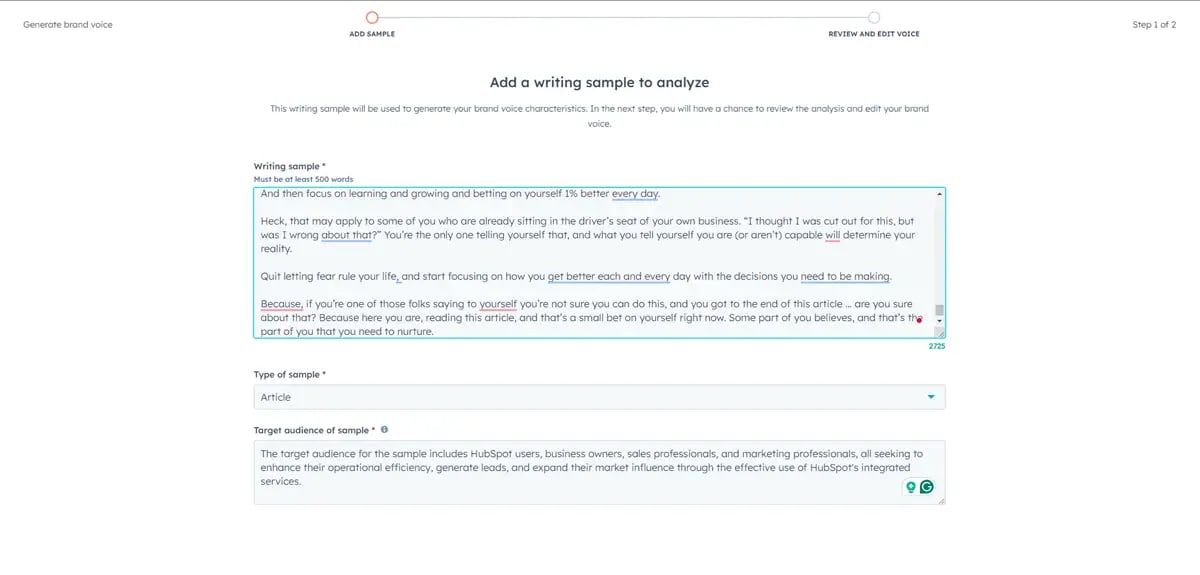
Why is HubSpot AI Brand Voice Important?
A consistent brand voice helps build trust and reliability with your audience. It makes your brand recognizable across different platforms and touchpoints, enhancing brand recall. The AI Brand Voice feature ensures that no matter who in your team creates content, the output remains uniformly aligned with your brand's core messaging and style.
💥 Get Help: Sidekick Strategies Can Help You with Brand Voice + Tone
As businesses grow and the volume of content production increases, maintaining a consistent voice across all communications can become challenging. The AI Brand Voice tool scales your content creation efforts without diluting the quality or consistency of your brand voice, even when multiple team members are involved in the content creation process.
A distinct and consistent brand voice can significantly improve how customers engage with your content. It helps form a deeper connection and a sense of familiarity, which are crucial for customer loyalty and engagement.
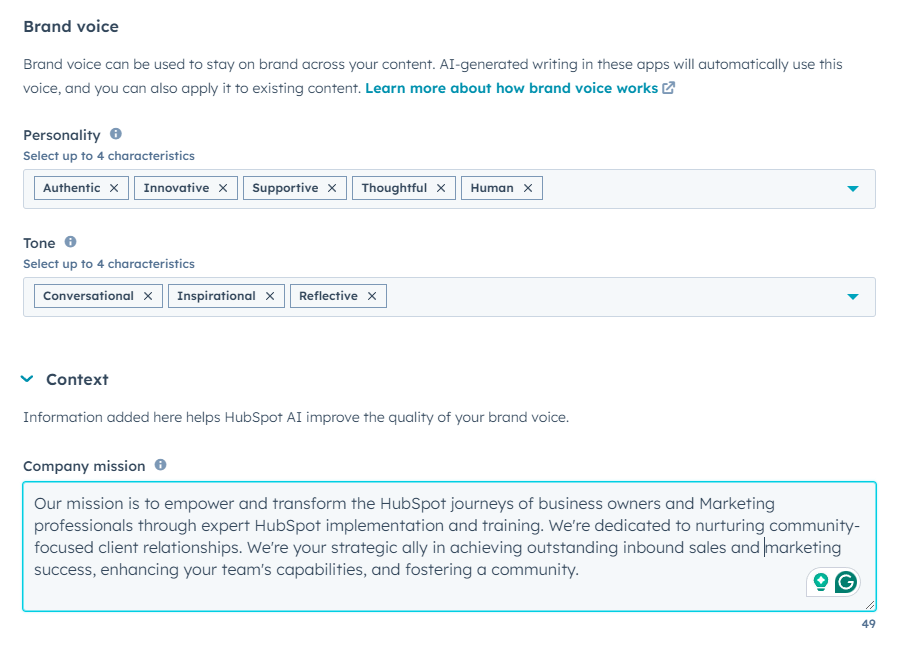
How HubSpot AI Brand Voice Can Help You
The AI Brand Voice feature streamlines content creation by providing guidelines and real-time suggestions. It is an automated editor that reviews content for voice consistency, making it easier for teams to produce aligned content faster. Understanding and adopting the brand's voice can take time for new team members.
💥 Related: Brand Voice + Tone Deep-Dive Inside HubSpot's Content Hub
The AI Brand Voice feature can serve as a training tool that provides immediate feedback and suggestions, speeding up onboarding and ensuring new content creators align with the brand's standards. Brand voice consistency often relies heavily on specific individuals who may understand the brand's tone better than others. This feature democratizes the ability to produce on-brand content, reducing dependence on individual talent and minimizing risk.
The AI Brand Voice feature acts as a quality control mechanism, ensuring all content meets the brand's standards before publication. This automated oversight can save significant time and resources in content review and revisions. HubSpot's AI Brand Voice feature is an invaluable asset for any business serious about maintaining a solid and consistent brand identity through its content.
This tool empowers marketers and business owners to fortify their brand presence in a competitive digital landscape by ensuring consistency, scalability, and engagement. Embracing this feature can transform how your brand communicates, making every piece of content reflect your brand's core values and personality.
HubSpot AI Powered Blog Narrations: Transforming Text into Engaging Audio
HubSpot's AI-powered Blog Narrations is an innovative feature designed to enhance content accessibility and engagement by transforming written blog posts into high-quality audio narrations.
This tool leverages advanced AI voice technology to create engaging and natural-sounding audio versions of your written content, making it easier for audiences to consume information in the format that suits them best. Understanding the capabilities of this feature, its importance, and how it can benefit business owners and marketers is crucial for leveraging modern content consumption trends.
What is HubSpot Content Hub AI Powered Blog Narrations?
AI-Powered Blog Narrations in the HubSpot Content Hub is a feature that automatically converts text-based blog posts into spoken audio files using AI-driven voice synthesis technology. This tool allows businesses to provide an audio option for their blog readers, catering to the growing demand for audio content such as podcasts and audiobooks. It supports various voice types and languages, enabling a broad reach and personalization to fit the brand's tone and audience preferences.
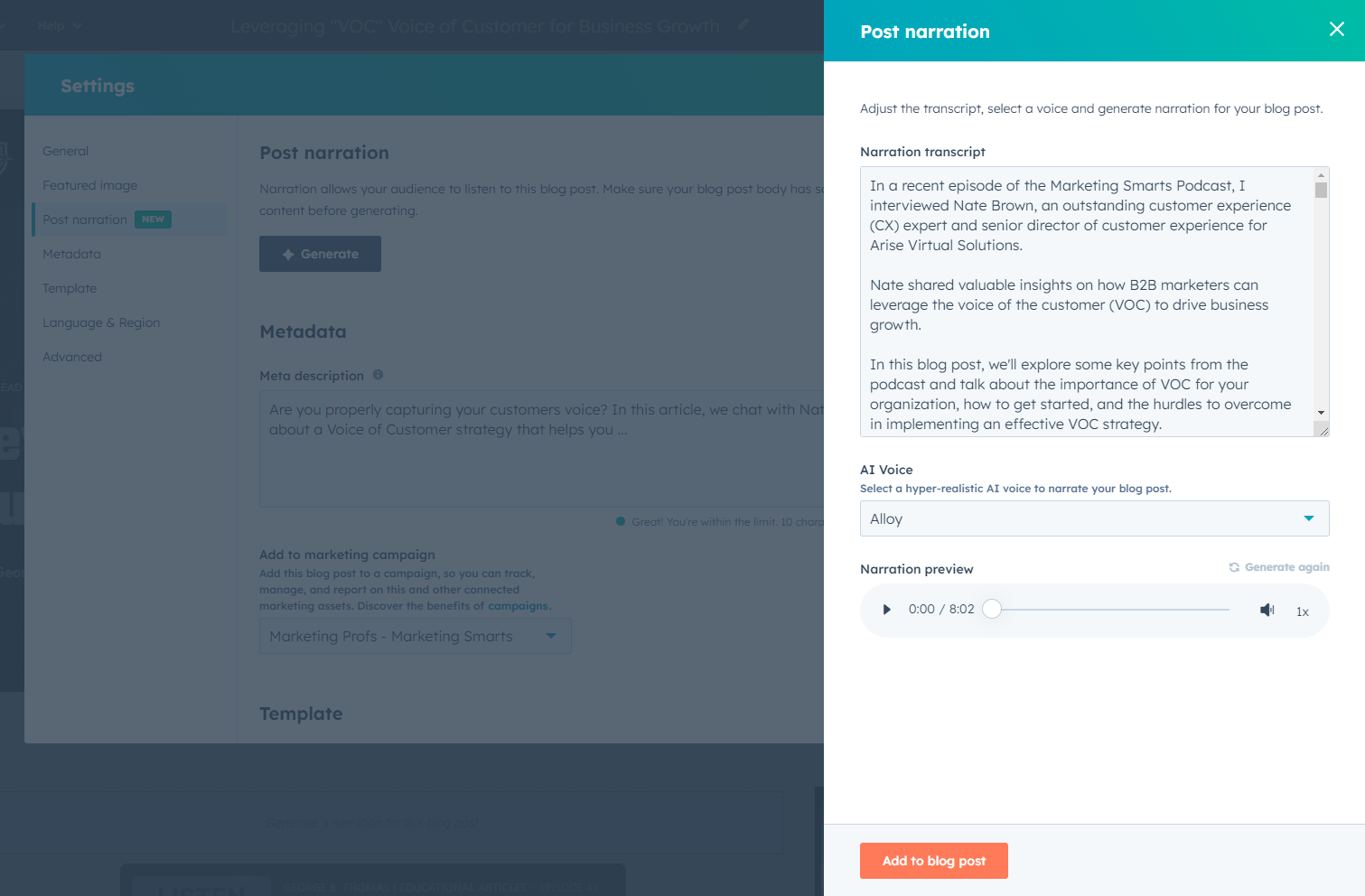
Why is HubSpot Content Hub AI Powered Blog Narrations Important?
By offering an audio version of blog posts, companies can cater to users who prefer auditory learning or consume content on the go, such as while commuting or exercising. This accessibility broadens the reach of your content and ensures that a more diverse audience can enjoy it.
💥 Related: Unleashing the Power of Community + Brand-Building
Audio content has been shown to have high engagement rates, with listeners often consuming most or all of the provided content. AI-powered blog Narrations can help capture and retain your audience's attention more effectively than text alone, especially in an era where multitasking is every day.
Utilizing AI for audio narrations positions a brand as creative and adaptive to new technologies and consumer habits. It differentiates your content strategy by integrating multimedia elements that appeal to current consumer behaviors and preferences.
How AI-Powered Blog Narrations Can Help Marketers
Audio versions of blog posts allow businesses to tap into a broader market, including those who frequent audio platforms like Spotify and Apple Podcasts. This expansion can significantly increase your content's visibility and engagement. Audio content can improve your overall SEO strategy. Hosting audio narrations on your site and submitting them to audio search engines and directories can attract more traffic and improve your online presence.
AI-Powered Blog Narrations provide a cost-effective way to repurpose existing content. Transforming written content into audio formats extends the life and reach of your original investments without the need for extensive resources or new content creation.
💥 Related: Business Leaders, It's Time to Prioritize Employee Education + Development
Providing a choice between reading and listening can improve the user experience. It meets the audience's preferences, which can lead to increased satisfaction and loyalty. HubSpot's Content Hub AI-powered Blog Narrations feature is a powerful tool for modernizing content delivery and consumption. It reflects a shift towards more dynamic and accessible content formats, ensuring businesses remain competitive and relevant in a rapidly evolving digital landscape. By adopting this feature, marketers and business owners can significantly enhance the reach and impact of their content strategies, effectively catering to a broader and more diverse audience.
Integrating HubSpot Content Hub with Other Tools
When you harness the power of HubSpot's Content Hub, you're not just getting a standalone platform; you're plugging into a vast ecosystem that enhances and expands its capabilities through seamless integrations. Let's explain how the Content Hub collaborates with other critical tools to streamline your marketing efforts and amplify your impact.
Foundational CRM Integration
The cornerstone of any effective marketing strategy is a robust Customer Relationship Management (CRM) system, and HubSpot's Content Hub shines brightest when integrated with HubSpot CRM. This integration creates a seamless data flow between your content and the detailed insights about your audience stored in the CRM.
Every piece of content you publish feeds into a database that knows your customers' history, preferences, and engagement. This connection means you can tailor your content strategies based on customer behavior patterns and feedback captured by the CRM. For instance, if the CRM data shows a high engagement rate with specific topics among a segment of your audience, the Content Hub can help prioritize and push more of that content.
It's like having a continuous feedback loop where content performance informs customer understanding, shaping future content creation. Can I get an Amen and a Hallelujah?
Social Media and Marketing Automation
Integrating the Content Hub with social media tools and marketing automation systems supercharges your ability to distribute content effectively and measure its impact. The HubSpot Content Hub lets you schedule and publish content directly to your social media channels, ensuring that your content reaches your audience, where they spend most of their time online.

This integration saves time and enhances your social media strategy with rich insights from content interactions, which can be used to refine your approach in real time. Moreover, coupling the Content Hub with marketing automation tools within HubSpot allows for the creating of dynamic campaigns that respond to user interactions.
For example, if a user downloads a guide or subscribes to a newsletter, the system can automatically trigger a tailored series of emails or content suggestions, enhancing the lead nurturing process. This level of automation ensures that your content works harder and more intelligently, not just harder, maximizing return on investment and keeping your audience engaged through personalized touchpoints.
By integrating with these essential tools, the HubSpot Content Hub doesn't just manage your content; it turns it into a dynamic engine that drives engagement, nurtures leads, and delivers personalized experiences at scale. Whether through deep CRM integration or enhancing social media and marketing automation, the Content Hub is your central command, orchestrating a unified and compelling content strategy across all digital fronts.
Assessing the Fit for Your Business
Is HubSpot Content Hub Right for You?
Deciding whether HubSpot's Content Hub is the right tool for your business boils down to understanding your specific needs, goals, and the capabilities you require from a content management system. Let's dive into how you can assess these elements to make an informed decision.
Identifying Business Needs and Goals
Identify your key content-related needs and business goals to determine if the HubSpot Content Hub fits your business. Ask yourself:
- What are your primary content objectives?
- Are you looking to increase engagement, boost SEO, drive conversions, or enhance brand awareness?
Understanding your objectives will help determine if the Content Hub's features align with your goals.
- How complex is your content strategy?
If your strategy involves multiple channels, frequent publishing, and the need for detailed analytics, the Content Hub's comprehensive toolset might be necessary.
- Do you require integration with other tools?
Consider whether you need a platform that integrates seamlessly with CRM systems, social media platforms, and other marketing tools. The Content Hub excels in integration, making it a strong candidate if this is a priority.
- What level of customization and automation do you need?
The ability to automate content tasks and customize workflows can significantly impact efficiency and effectiveness, especially in larger teams or rapidly scaling businesses. By clearly outlining your needs and what you aim to achieve with your content, you can better gauge whether the HubSpot Content Hub will serve as the powerhouse you need to meet and exceed those goals.
Capabilities Checklist
Compiling a checklist of essential capabilities is helpful to clarify the decision-making process further. Consider whether the Content Hub provides the following:
- Comprehensive content management: Can it handle the creation, management, and optimization of all content types (blogs, social media posts, landing pages, etc.)?
- Advanced analytics and reporting: Does it offer the insights and data necessary to make informed decisions about your content strategy?
- AI-powered tools: Are the AI features relevant and sophisticated enough to benefit your content creation and optimization processes significantly?
- Integration potential: Does it integrate well with other tools and platforms you currently use or plan to use?
- Scalability: Can it grow with your business and adapt to increasing demands or expanding strategies?
- User experience: Is the platform user-friendly for all team members, regardless of their technical skills?
- Support and community: Does HubSpot provide adequate support and resources to help you maximize the platform's capabilities?
By going through this checklist, you can compare your specific requirements with the features and functionalities of the HubSpot Content Hub. If most or all of your criteria align with the capabilities of the Content Hub, it's likely a suitable choice for enhancing and elevating your content marketing efforts. This detailed evaluation ensures that the investment in such a platform is justified and positions your business for more tremendous content-driven success.
HubSpot Content Hub vs. WordPress, Drupal, etc.
Earlier, I mentioned that we are no longer calling it HubSpot CMS. However, it still has tools that put it in the conversations of being a choice to be a CMS for your website needs. Not to mention podcasting, but I'll talk about that later. So, how does the Hubspot Content Hub stand up against other traditional old-school CMS platforms? If you want a deeper look, check out the additional resource below.
🔎 Content Hub vs. WordPress (When Live)
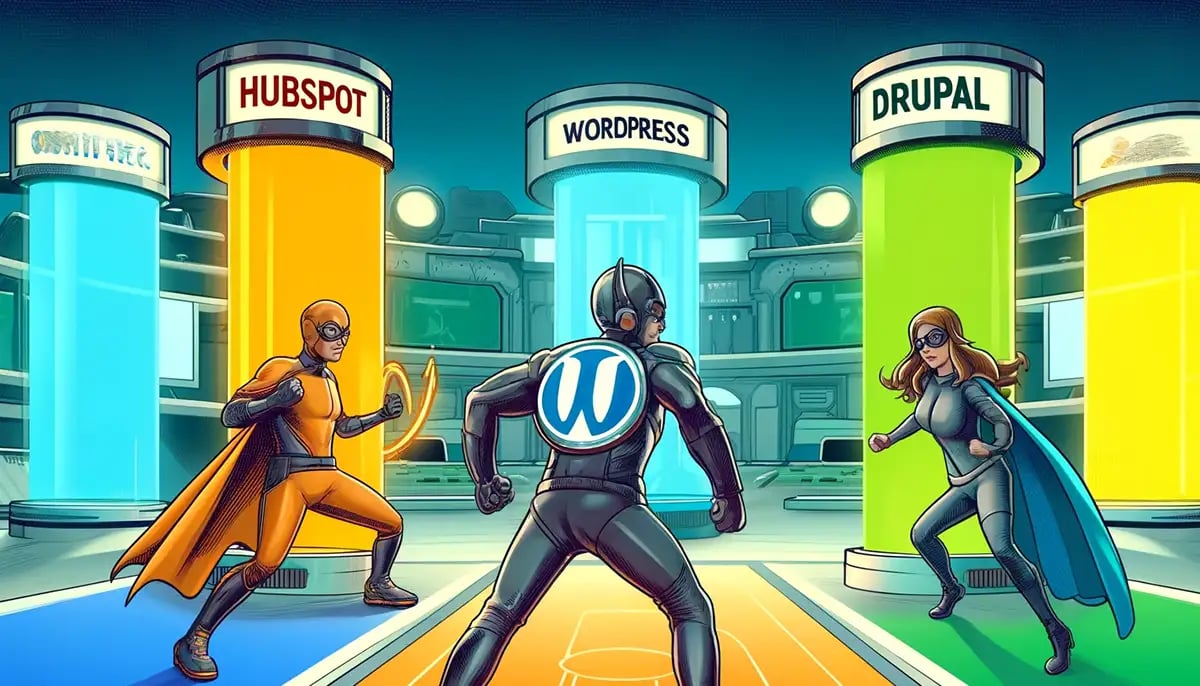
While a relatively newer player in the CMS arena, HubSpot's Content Hub brings unique capabilities that can be compared with traditional systems like WordPress and Drupal. Let's break down these differences to see why HubSpot might be the superior choice for certain businesses.
All-in-One Integration
Unlike WordPress and Drupal, which often require the integration of various plugins and tools to achieve full functionality, HubSpot Content Hub offers a comprehensive, all-in-one suite of tools. This integration extends beyond content management to include email marketing, social media management, SEO, CRM functionalities, and more, all within the same ecosystem. This reduces the complexity and potential compatibility issues between different plugins and tools.
Built-in CRM
One of HubSpot's standout features is its native integration with its powerful CRM system. This integration allows seamless interaction between content and customer data, enabling marketers to tailor content based on customer interactions and insights. In contrast, platforms like WordPress and Drupal require additional plugins or external software to achieve similar CRM functionalities.
User-Friendly Interface
HubSpot is designed for usability, making it accessible to all skill levels. WordPress and Drupal, while highly customizable, often have steeper learning curves and can be daunting for users without technical backgrounds. HubSpot's intuitive design and built-in guidance help users quickly learn how to navigate and make the most of the platform.
Enhanced Security and Support
HubSpot offers robust security features and dedicated support directly from its team. This is a significant advantage over open-source platforms like WordPress and Drupal, which can be vulnerable to security risks if not adequately maintained and require users to rely on community support or third-party services for help.
Feature-by-Feature Comparison
Content Creation and Management:
- HubSpot: Offers drag-and-drop editors, SEO recommendations, and content staging environments.
- WordPress/Drupal: These platforms are highly customizable through themes and plugins, but they often require more manual setup for SEO and layout changes.
Analytics and Reporting:
- HubSpot: Advanced analytics are built-in, providing detailed reports on content performance, user engagement, and conversion tracking integrated with other marketing data.
- WordPress/Drupal: Basic analytics are available, but advanced tracking generally requires integration with third-party tools like Google Analytics.
Customization and Flexibility:
- HubSpot: Due to its proprietary nature, HubSpot is somewhat less open to deep customization. However, it offers a wide range of ready-to-use templates and modules that are optimized for performance and conversions.
- WordPress/Drupal: Offer extensive customization capabilities through thousands of plugins and themes, which can be tailored to meet nearly any need.
Scalability:
- HubSpot: Easily scales with your business, supporting everything from small startups to large enterprises without the need for significant changes to the setup.
- WordPress/Drupal: This can scale effectively but might require significant technical adjustments and optimizations as the site grows and traffic increases.
By understanding these key differences and assessing which features align best with your business needs, you can decide whether HubSpot Content Hub or another CMS like WordPress or Drupal is the right choice for your content strategy.
Before discussing best practices, mastering your content marketing, or advanced features, I want to discuss one of the HubSpot Content Hub tools I'm most excited about. Drum roll, please.
HubSpot Podcast: Elevating Your Brand's Voice Through Audio
HubSpot's Podcast feature is a dynamic tool designed to streamline podcasting integration into your broader content marketing strategy. This feature simplifies the podcasting process while enhancing its impact by enabling businesses to produce, manage, and analyze podcasts directly within the HubSpot ecosystem.
Understanding the Podcast feature, its significance, and how it can propel your business forward is essential for marketers and business owners aiming to expand their reach and deepen audience engagement.
What is the HubSpot Podcast Feature?
The HubSpot Podcast feature is a robust suite of tools that facilitates the entire podcasting process from a single platform. This integration makes it easier to manage podcasts alongside other marketing efforts and provides essential tools for recording, editing, and publishing episodes.
Additionally, it supports distribution across major podcast platforms like Apple Podcasts and Spotify, ensuring your content reaches a broad audience.
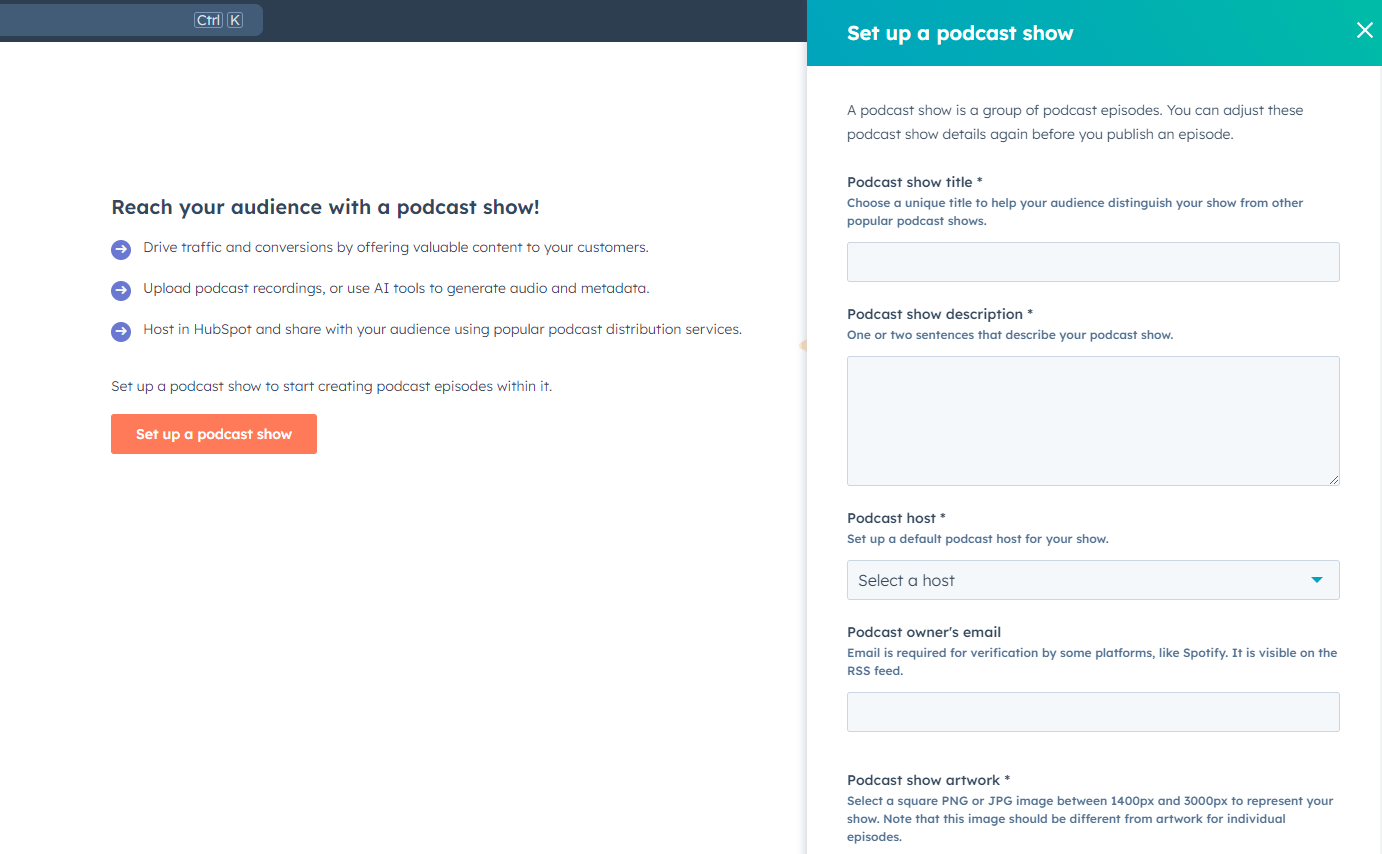
The Importance of Podcasting in Modern Marketing
Podcasts create a unique space for brands to connect with their audience personally. Their conversational nature makes your brand more relatable and accessible, fostering a stronger emotional connection with listeners.
Regular podcast episodes allow you to showcase your expertise and share insights on industry trends, positioning your brand as a thought leader. We frequently highlighted this on the HubHeroes Podcast, emphasizing how podcasts can transform your brand's perception in your audience's minds.
Incorporating podcasts into your content portfolio caters to your audience's audio content consumption preferences and enriches your overall content strategy. It opens up new avenues for content repurposing and cross-promotion, such as turning blog articles into podcast discussions or following up podcast episodes with detailed guides or infographics.
Strategic Considerations for Your Business Podcast
Consider how your podcasts can complement and enhance your existing content initiatives. For example, you might discuss topics covered in your blogs or eBooks on your podcast, providing a more in-depth exploration or new perspectives that add value for your audience.
Podcasts provide a platform for building a community around your content. Encourage listener interaction by inviting them to submit questions or feedback and involving them in topic selection. This approach keeps the content relevant and makes your audience feel valued and heard.
Leveraging HubSpot's analytics capabilities can offer profound insights into your podcasts' performance. Metrics like listener demographics, engagement rates, and download numbers can help you fine-tune your content and promotional strategies to meet your audience's needs better.
The Transformative Power of Podcasting for Business Growth
Podcasts have the potential to reach a global audience, providing a significant boost to your brand's visibility. They are easy to consume on the go, appealing to busy professionals and consumers who might listen while commuting, exercising, or during downtime. Effective call-to-action use within your podcast episodes can guide listeners toward your website or special offers, converting them from casual listeners to potential leads and customers.

As we often discussed on the HubHeroes Podcast, one of the most exciting aspects of podcasting is its ability to build a dedicated community of listeners. Regular engagement with this community fosters loyalty and turns listeners into brand advocates who are likely to spread the word about your business.
💥 Related: What is the HubSpot Flywheel? Is the funnel dead? (HubHeroes Podcast)
The HubSpot Podcast feature is more than just a tool; it's a gateway to expanding your brand's reach, enhancing its authority, and deeply engaging with your audience. As we've expressed through our own experiences on the HubHeroes Podcast, embracing this feature can lead to remarkable growth and opportunities for any business ready to invest in the powerful podcasting medium.
Content Strategy Development Best Practices
To maximize the impact of your HubSpot Content Hub, developing a robust content strategy is crucial. This strategy should align closely with your business goals, audience needs, and marketing objectives. Here are key considerations and steps to ensure your content strategy is both practical and sustainable:
-
Define Your Goals: Start by clearly defining what you want to achieve with your content. Whether it's increasing brand awareness, driving more traffic, improving conversion rates, or enhancing customer engagement, your goals should guide every piece of content you create.
-
Understand Your Audience: Develop a deep understanding of your target audience. Use HubSpot's CRM data to analyze audience behaviors and preferences. This insight allows you to tailor your content to meet your audience's needs and interests.
-
Map Content to the Buyer's Journey: Each content piece should serve a purpose along the customer's journey. From awareness through consideration to decision, strategically design content that moves users towards conversion.
-
Create a Content Calendar: Use HubSpot's scheduling tools to plan and organize your content publication. A well-planned content calendar ensures a consistent flow of content and covers a variety of formats and themes aligned with your strategic goals.
Utilizing HubSpot's Analytics for Content Optimization
To continually engage and retain your audience, leveraging analytics for content optimization is vital:
-
Track Performance Metrics: Use HubSpot's analytics tools to track key performance indicators such as page views, bounce rates, engagement time, and conversions. Analyze what works and what doesn’t.
-
A/B Testing: Regularly test different versions of your content to determine what resonates best with your audience. HubSpot enables you to perform A/B testing on almost every aspect of your content, from email subject lines to different versions of webpage content.
-
Feedback Loops: Set up mechanisms to collect and analyze feedback directly from your audience. Use surveys, comment sections, and feedback forms to gather insights and adjust your content strategy based on this feedback.
-
Refine SEO Practices: Utilize HubSpot's SEO recommendations to optimize your content for search engines. Regularly update your SEO tactics based on the analytical insights provided by HubSpot regarding search trends and keyword performance.

By implementing these best practices in content strategy development and engaging your audience through personalization and data-driven optimizations, you can significantly enhance your content marketing efforts using HubSpot Content Hub.
Mastering Marketing and Creating Compelling Content
Content is the cornerstone of all marketing strategies. HubSpot's Content Hub equips you with the tools and insights to create compelling content that attracts and retains customer attention. Leveraging HubSpot's capabilities can significantly enhance your content creation process, making it smoother and more efficient. Here's a deeper dive into how to make the most of these tools.
💥 Related: Why Are Most Companies Failing with AI + Content?
HubSpot offers an array of content creation tools designed to streamline your workflow. The platform's rich text editor is perfect for crafting SEO-friendly and visually appealing blog posts. Additionally, HubSpot provides various design tools that assist in creating engaging infographics and interactive content, which are great for boosting user engagement. SEO is critical in ensuring your content reaches as broad an audience as possible, and HubSpot's built-in SEO tools guide you every step of the way. These tools provide real-time optimization tips, including keyword inclusion and meta descriptions, helping you optimize your content for search engines from the beginning.
Staying ahead of the curve is essential in today's fast-paced digital world. HubSpot's AI-powered capabilities are a game-changer in this regard. They help generate fresh content ideas based on trending topics and historical performance data, ensuring you produce content that resonates with both current and potential customers.
Creativity can sometimes stall; thankfully, HubSpot comes to the rescue with Remix, content templates, and inspiration. These resources are invaluable for structuring a blog post, designing a landing page, or crafting an email campaign. They kickstart your creative process and help maintain a high-quality standard in your content production.

Lastly, the importance of feedback cannot be overstated. HubSpot integrates customer feedback tools that allow you to gather direct insights from your audience. This feedback is crucial for refining your content and ensuring it meets your audience's needs and preferences, enhancing engagement and satisfaction. By integrating these strategies into your content development routine, you harness the full power of HubSpot to create compelling, effective, and high-quality content that drives engagement and reaches your marketing goals.
Managing Multi-Channel Content Strategies
Content must be distributed across multiple channels to maximize reach and impact. HubSpot Content Hub excels at managing multi-channel content strategies effectively. How, you ask?
Let's dig in and see.
-
Centralized Content Management: Manage all your content from a single platform. HubSpot's Content Hub allows you to coordinate campaigns across blogs, social media, email newsletters, and more, ensuring consistent messaging across all channels.
-
Automated Publishing Tools: Schedule content for automatic publishing across different platforms at optimized times. HubSpot can analyze when your audience is most active on each channel and recommend the best times to post, increasing the likelihood of engagement.
-
Monitor Engagement Across Channels: With HubSpot's comprehensive analytics dashboard, track your content's performance on different channels from one location. Understand where you're getting the most engagement, which types of content are performing best, and how different audience segments react to various content formats.
-
Cross-Channel Campaigns: Design and execute campaigns that span multiple platforms. HubSpot's workflow tools allow you to create interconnected content journeys that guide potential customers from initial awareness to final purchase decisions.
-
Integration with Social Media and Other Platforms: HubSpot seamlessly integrates with major social media platforms, enabling you to post directly from the HubSpot dashboard. Additionally, integrations with tools like Google Analytics, Salesforce, and others provide a holistic view of how your content contributes to your overall marketing goals.
By leveraging HubSpot to create compelling content and manage multi-channel strategies, marketers can ensure their content is high quality and perfectly aligned with their broader marketing objectives. This holistic approach facilitated by HubSpot can significantly enhance the effectiveness of your content marketing efforts.
Advanced Features and Customization
HubSpot's Content Hub is not just a content management system; it is a powerful engine driven by advanced automation and AI features that transform how you engage with your audience. These capabilities streamline your marketing efforts and enhance user interactions through intelligent automation and personalized experiences.
Automation and AI Features
HubSpot takes content creation to the next level by automating several aspects of the lifecycle, making it easier and faster to produce engaging content consistently. Automation is revolutionizing content creation by streamlining processes and ensuring content quality, and HubSpot is at the forefront of this transformation. Let's explore how HubSpot's automated tools enhance how content is crafted and delivered.
💥 Related: What is inbound? How has it changed? (HubHeroes Podcast)
Firstly, HubSpot offers an array of content templates and blueprints that automate the structure of your content creations. Whether you're drafting blog posts, designing emails, or updating your social media channels, these templates are tailored to meet specific content needs. This accelerates the creation process and ensures the output maintains a consistent, high-quality level. By automating these structures based on the most successful formats, HubSpot removes much of the guesswork in content creation.
Moreover, HubSpot harnesses the power of AI to elevate your content strategy. The platform's AI capabilities analyze your past content performance and levels of audience engagement to provide targeted content suggestions. These recommendations help fine-tune your strategy in real time, suggesting timely, highly relevant topics and engaging your audience. This ensures that your content stays on the cutting edge, perfectly aligned with what your audience wants to consume.

Additionally, HubSpot enables dynamic content creation, an innovative approach that applies content based on user data and interactions. For example, when managing an email marketing campaign, HubSpot can automatically personalize emails for each recipient. This customization increases the relevance of your messages, significantly enhancing the effectiveness of your communications. By dynamically adjusting content, HubSpot ensures that each piece of communication feels personal and valuable to the recipient, increasing engagement rates and strengthening customer relationships.
HubSpot's automation tools simplify the content creation process and enhance its effectiveness by ensuring that each piece of content is as relevant, engaging, and high-quality as possible. This level of automation and personalization sets HubSpot apart, making it an indispensable tool for modern marketers aiming to stay ahead in a fast-paced digital world.
Personalizing User Experiences
Personalization is critical to building lasting relationships with your audience, and HubSpot’s AI and automation tools make personalization at scale both achievable and straightforward:
-
Smart Content: Use HubSpot's smart content feature to personalize website and email content based on visitor data. This feature adjusts what visitors see based on their location, device, past interactions, and stage in the buying process, creating a tailored browsing experience that increases engagement and conversion rates.
-
Behavioral Trigger Automation: Set up automated workflows that trigger based on specific user behaviors. For example, if a user spends a significant amount of time on a particular product page, HubSpot can automatically send them a targeted email with more information on the product or a limited-time discount to encourage purchase.
-
Segmentation and Targeting: HubSpot allows you to segment your audience based on various criteria, including demographic data, behavior, and engagement levels. Content and messaging can be customized for each segment, ensuring your marketing messages are consistently targeted and relevant.
-
Predictive Lead Scoring: Use HubSpot's predictive lead scoring system to automatically assess leads' potential based on their engagement with your content. This feature helps prioritize leads more likely to convert, allowing you to tailor your follow-up communications effectively.
By leveraging these advanced features for automation and AI, HubSpot Content Hub not only simplifies content management but also enhances the impact of your marketing efforts through intelligent personalization and automation. This leads to more effective marketing strategies, improved customer experiences, and higher conversion rates.
Integrating with Sales, Marketing, and Service Hubs
When integrated with the Sales, Marketing, and Service Hubs, HubSpot's Content Hub creates a seamless operational flow that enhances the efficiency and effectiveness of your business strategies.
💥 Related: HubSpot contacts mastery is the key to HubSpot ROI
This integration ensures that all customer interactions, whether marketing, sales, or service-related, are informed by and contribute to the unified content strategy, creating a cohesive customer journey.
Example: Creating a Unified Customer Experience
Integrating the Content Hub with the Marketing, Sales, and Service Hubs allows for a consistent customer experience across all touchpoints. This holistic approach ensures that every piece of content a customer interacts with is aligned with their stage in the buyer's journey and personal preferences, which are understood and managed across departments.
Here's how this integration enhances customer experience:
-
Consistent Messaging Across Channels: Ensure that all communications, whether for sales, marketing, or customer service, maintain a consistent tone, style, and message. This consistency helps reinforce your brand's voice and builds customer trust.
-
Customer Insights Sharing: Leverage CRM insights to inform content creation in the Content Hub. Sales interactions and service tickets provide valuable information about customer needs and pain points, which can guide targeted content development.
-
Automated Content Delivery: Automatically deliver personalized content at critical moments in the sales or service process. For example, if a sales representative identifies a potential interest in a particular product, the system can automatically send educational content or case studies relevant to that product, enhancing the sales conversation.
Streamlining Operations and Content Across All Departments
When your content management system works harmoniously with sales and service, operations are streamlined, reducing friction and improving efficiency. This integrated approach not only saves time but also enhances the quality of customer interactions.
Integrating systems within a business to create a single source of truth for customer data is a transformative strategy that can enhance efficiency and improve customer interactions across all departments. Maintaining this unified system eliminates data silos that traditionally segment customer information between marketing, sales, and service teams. By having everyone access the same up-to-date data, businesses significantly reduce the risk of presenting conflicting information to customers, ensuring a smoother and more reliable customer experience.
The power of enhanced workflow automation cannot be underestimated. Businesses can operate more efficiently by setting up automated workflows that trigger actions across various departments. For instance, when a piece of content achieves a high engagement score, this can automatically alert the sales team to follow up with the engaged individuals. This ensures that potential leads are acted upon promptly and maximizes the chances of converting interest into sales, optimizing the responsiveness of your teams.

Establishing a robust feedback loop is crucial for continuous improvement. Feedback from sales and service interactions can be invaluable in refining content strategies. Understanding directly from your customer interactions what content resonates doesn't allow businesses to tailor their approach for better engagement and effectiveness. This direct line of insight enables marketers to fine-tune their content continually, ensuring that it not only meets but exceeds customer expectations, thereby enhancing the overall impact of their marketing efforts.
💥 Related: Do you need an in-house HubSpot Super Admin? (HubHeroes Podcast)
Adopting a unified database for customer data, implementing enhanced workflow automation, and creating a feedback loop are all strategic moves that drive significant improvements in business operations and customer engagement. These integrations and strategies ensure businesses remain agile, responsive, and customer-focused in today's competitive landscape.
Your business can create a more connected and responsive ecosystem by integrating the HubSpot Content Hub with the Marketing, Sales, and Service Hubs. These integrations improve internal efficiency and enhance the customer experience, making it more personalized and seamless across all interactions with your brand.
Future of Content Marketing with HubSpot
As we look ahead, the future of content marketing with HubSpot appears promising and revolutionary. HubSpot consistently leads innovation, integrating the latest technological advancements to ensure businesses using its platform stay competitive in an ever-evolving digital landscape.
Let's explore some of the anticipated features and innovations that will continue to shape the future of content marketing.
Upcoming Features and Innovations (Our Crystal Ball 🔮)
HubSpot is continuously evolving, with developments aimed at enhancing the functionality and efficiency of the Content Hub. Here are a few innovations to look forward to:
-
Enhanced AI Capabilities: We think that HubSpot plans to integrate artificial intelligence into the Content Hub further, making AI not just a tool for suggestions but an integral part of content creation, distribution, and optimization processes. Expect more innovative content analytics, automated content customization, and sophisticated audience targeting tools.
-
Increased Integration Options: As the digital marketing ecosystem expands, so does the need for more comprehensive integration capabilities. We expect that HubSpot will offer even broader integration with external tools and platforms, ensuring that it can serve as the central hub for all digital marketing activities, regardless of your software or platforms.
-
Advanced Predictive Analytics: We think future Content Hub updates will include more advanced predictive analytics features, allowing marketers to forecast content trends and customer behaviors accurately. This forward-looking data will enable marketers to prepare more proactive marketing strategies that are data-driven and results-oriented.
-
Interactive and Immersive Content Features: Recognizing the shift towards more dynamic content, we believe HubSpot will enhance its support for interactive and immersive content types like augmented reality (AR) and virtual reality (VR). This will allow brands to deliver cutting-edge experiences directly through the HubSpot platform.
Why Staying Ahead with HubSpot Is Essential for Growth
Adopting and adapting to HubSpot's Content Hub isn't just about leveraging a powerful tool but embracing a strategic partner that propels your business forward. Staying ahead in the fast-paced world of digital marketing is essential for maintaining competitiveness, and HubSpot is at the forefront of providing the tools necessary to achieve this.
💥 Related: How to measure content marketing ROI the right way (+ examples)
By continuously updating and innovating, HubSpot ensures that your marketing strategies are practical and cutting-edge. This is crucial as staying ahead of technological trends and evolving customer expectations can make the difference between leading the market and falling behind.
As businesses grow, the need for scalable solutions becomes critical. HubSpot meets this demand with scalable content marketing tools that adapt as your company expands. This means that as your business grows in size and complexity, your marketing efforts can scale accordingly without a drop in effectiveness. Such scalability ensures that your marketing infrastructure supports growth rather than hinders it.

Efficiency and a strong return on investment (ROI) are paramount in any business operation. HubSpot enhances both by streamlining marketing operations through smart integrations and automation. These features reduce the need for manual labor and minimize the likelihood of errors, allowing your team to focus on strategic and creative efforts that drive business growth.
💥 Related: AI, ChatGPT, and the future of inbound marketing
This saves time and optimizes your resource allocation, boosting your overall ROI. HubSpot's robust analytics and advanced predictive capabilities give businesses insight-driven strategies. This data-centric approach allows for the continuous refinement of marketing tactics, ensuring that every piece of content and every campaign is optimized for performance.
By understanding what truly engages and converts, you can make informed decisions that enhance the effectiveness of your marketing efforts and provide real value to your customers. Leveraging HubSpot's comprehensive suite of tools is essential for any business aiming to stay competitive, scalable, efficient, and insightful in today's dynamic market environment. With its forward-thinking technology and insights, HubSpot supports current operational needs and propels businesses toward future success.
As content marketing continues to evolve, HubSpot's commitment to innovation and integration makes it an indispensable tool for any business serious about content strategy. Staying ahead with HubSpot means keeping pace with current trends setting the pace and ensuring long-term growth and success in the digital arena.
Final Thoughts and Inspirational Takeaway
As we wrap up our exploration of HubSpot's Content Hub, it's clear that this platform is more than just a tool; it's a comprehensive solution designed to elevate your content marketing to new heights. Let's revisit some of the standout benefits and features before leaving you with some inspiration to move forward.
💥 Related: Essential HubSpot Renewal Considerations (HubHeroes Podcast)
As you stand on the brink of deciding how to propel your content marketing forward, consider what HubSpot's Content Hub offers not just as a platform but as a partner in your growth. Embracing HubSpot means choosing a path of innovation, efficiency, and strategic foresight. It's about more than adopting new software—committing to a philosophy that values customer engagement, data-driven marketing, and continuous improvement.
-
Embrace Innovation: In a world where change is the only constant, staying ahead means embracing innovation. HubSpot is continually evolving, bringing you the latest marketing technology to keep you at the forefront of your industry.
-
Trust in Data: Let go of guesswork and make decisions based on robust data. HubSpot's analytics empower you to understand your audience deeply, refine your tactics, and maximize the impact of your content.
-
Grow Together: As your business grows, HubSpot grows with you. Its scalable solutions ensure that no matter the size of your operation or the scope of your ambitions, you have a platform that fits your needs every step.
Remember, the journey of a thousand leads begins with a single piece of content. And with HubSpot's Content Hub, you're not just creating content; you're crafting experiences, building relationships, and setting the stage for lasting business success. So, take the step, embrace HubSpot, and watch as your content and business reach new heights.
Let's move forward together, innovate relentlessly, and build a future where every interaction matters. Please let us know if you have thoughts or questions or need help with the HubSpot Content Hub.
HubSpot Content Hub FAQs
-
What is HubSpot Content Hub?
HubSpot Content Hub is an integrated platform that simplifies the management of your content marketing strategies. It combines tools for content creation, management, optimization, and analytics into a single, user-friendly system, helping businesses streamline their content processes and measure their impact effectively.
-
Who should use HubSpot Content Hub?
HubSpot Content Hub is ideal for marketers, content creators, and business owners who need to manage multiple aspects of content marketing across different channels. It is particularly beneficial for those looking to automate and optimize their marketing workflows and desire a unified view of their content’s performance.
-
How does HubSpot Content Hub integrate with other HubSpot products?
HubSpot Content Hub seamlessly integrates with other HubSpot hubs, such as the Marketing Hub, Sales Hub, and Service Hub. This integration allows for a cohesive strategy that aligns sales, marketing, and customer service, ensuring consistent messaging and improving the overall customer experience.
-
Can HubSpot Content Hub help with SEO?
Yes, HubSpot Content Hub includes built-in SEO tools that help users optimize their content for search engines. These tools provide recommendations for improving on-page SEO, such as keyword inclusion, meta descriptions, and more, helping your content rank higher in search engine results.
-
What types of content can I create with HubSpot Content Hub?
Users can create a variety of content types using HubSpot Content Hub, including blog posts, social media updates, email campaigns, landing pages, and more. The platform offers rich text editors, design tools, and customizable templates to support diverse content creation needs.
-
Is HubSpot Content Hub suitable for small businesses?
Absolutely. HubSpot Content Hub offers scalable solutions that are suitable for businesses of all sizes, from small startups to large enterprises. The platform's flexibility and range of pricing options make it accessible for small businesses looking to grow their online presence effectively.
-
How does the AI-powered content generation work?
HubSpot’s AI-powered content generation tools analyze your existing content and performance data to suggest new content topics and formats that are likely to engage your audience. These tools can also help generate draft content, saving time and resources in the content creation process.
-
How does HubSpot Content Hub enhance content personalization?
HubSpot Content Hub allows for advanced content personalization strategies through its smart content features and integration with HubSpot CRM. These capabilities enable you to tailor your content based on user behavior, preferences, and data, ensuring that each piece of content is relevant to its intended audience.
-
Can I measure the ROI of my content marketing efforts with HubSpot Content Hub?
Yes, HubSpot Content Hub includes comprehensive analytics tools that track the performance of your content across various channels. These insights can help you measure the return on investment (ROI) of your content marketing by providing data on engagement, conversion rates, and other key performance indicators.
-
What kind of support does HubSpot offer for Content Hub users?
HubSpot provides extensive support for Content Hub users, including access to the HubSpot Academy for training resources, a dedicated customer support team, and a community forum where users can share tips and ask for advice from other marketers.


